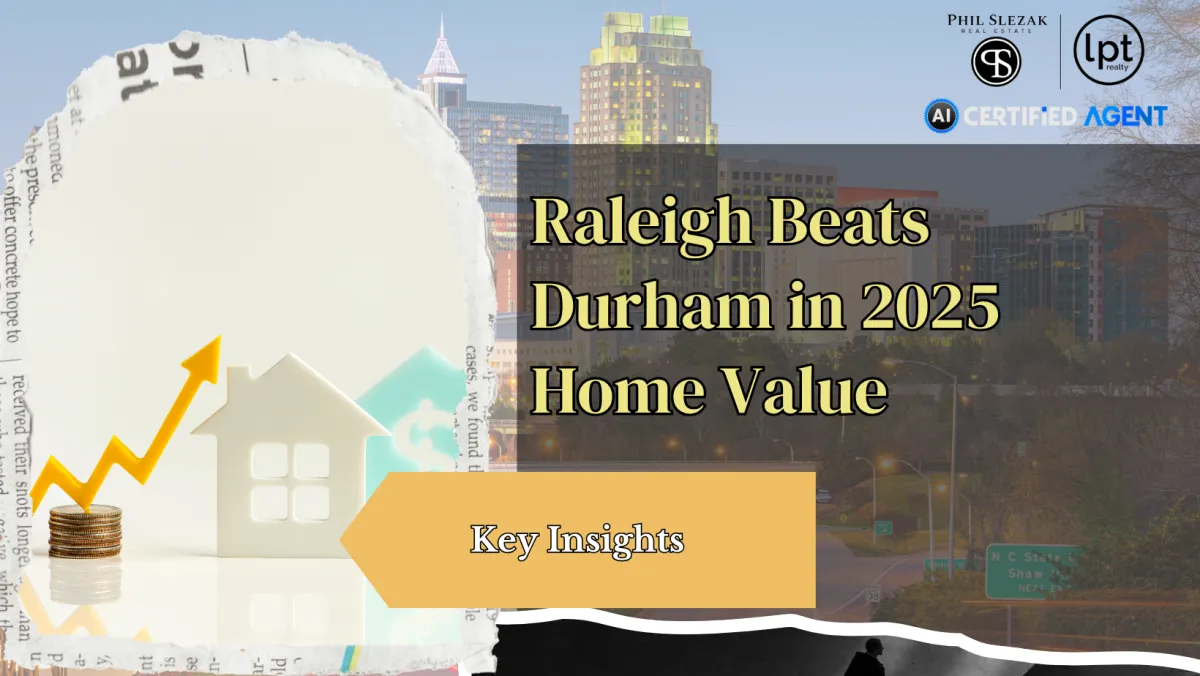
The Triangle Advantage: Raleigh’s Home Value Edge
The Triangle Advantage: Why Raleigh Beats Durham & Chapel Hill for Home Value
When it comes to choosing where to buy a home in North Carolina’s Research Triangle, three names dominate the conversation — Raleigh, Durham, and Chapel Hill. Each has its charm, culture, and unique housing market. But when it comes to long-term home value, appreciation, and overall livability, Raleigh stands out as the clear winner in 2025.
Backed by data from Zillow and Redfin, Raleigh leads the Triangle region in both median home appreciation and resale value, while maintaining better affordability than its western counterparts.
“Raleigh’s balance of affordability, opportunity, and quality of life makes it the strongest long-term investment in the Triangle.” — Phil Slezak
1. The Triangle’s Real Estate Overview: 2025 Snapshot
The Research Triangle’s three main cities—Raleigh, Durham, and Chapel Hill, continue to attract buyers from across the U.S. for their economic stability, educational excellence, and livability.
Raleigh: Median home price of $435,000, appreciation rate of 5.8% year-over-year, and inventory up 9% due to new construction.
Durham: Median home price of $465,000, appreciation rate 4.1%, with tighter inventory due to limited land.
Chapel Hill: Median home price of $570,000, appreciation rate 3.5%, driven by luxury and university proximity.
Raleigh’s growth trajectory outpaces its neighbors due to better infrastructure, diverse housing stock, and proximity to key employment centers.

2. Why Raleigh Wins on Home Value
Affordability Meets Appreciation
Raleigh offers buyers more square footage and newer construction for their money. According to Realtor.com, homes in Raleigh cost approximately $185 per square foot, compared to $210 in Durham and $250 in Chapel Hill. This affordability, combined with strong appreciation, positions Raleigh as the most financially advantageous market.
Job Growth and Economic Expansion
Raleigh’s economy continues to outperform neighboring cities, driven by Research Triangle Park (RTP), which is expanding with companies like Apple, Google, and Biogen. Raleigh alone accounted for over 40% of new jobs created in the Triangle in 2025 (WRAL TechWire). This job growth sustains housing demand and drives consistent value gains.
Infrastructure and Accessibility
Unlike Durham’s limited transit corridors and Chapel Hill’s constrained growth policies, Raleigh benefits from ongoing infrastructure investments:
The I-540 Loop Completion connects emerging suburbs like Knightdale and Holly Springs.
GoTriangle commuter rail (under construction) will link Raleigh with Durham by 2027.
Continued investment in bike lanes and public transit improves livability and accessibility.
Balanced Development and Zoning
Raleigh’s master-planned growth encourages both urban and suburban expansion, ensuring steady home supply. In contrast, Chapel Hill’s restrictive zoning and Durham’s land constraints limit new development, driving up prices without proportional value increases.

3. Lifestyle and Quality of Life Advantages
Cultural and Recreational Balance
Raleigh offers more variety in lifestyle amenities — from its thriving arts scene to vast greenway systems and parks. The city maintains over 180 miles of greenways and multiple entertainment districts like North Hills, Glenwood South, and Downtown Warehouse District.
Education and Family Appeal
While Chapel Hill has the University of North Carolina, Raleigh benefits from access to NC State University, Meredith College, and William Peace University, along with top-rated K–12 schools under Wake County’s leadership.
Healthcare Access
Raleigh residents enjoy proximity to Duke Health, WakeMed, and UNC Health, giving them access to nationally ranked facilities without the higher costs associated with living directly in Durham or Chapel Hill.
4. Neighborhood Comparison: Raleigh vs. Durham vs. Chapel Hill
Raleigh: Offers diverse housing options, from downtown condos to suburban family homes. Top neighborhoods include North Hills, Five Points, Brier Creek, and Falls Reserve. Each area provides access to major employers and entertainment hubs.
Durham: Known for revitalized urban living and a strong food scene, neighborhoods like Trinity Park and Southpoint attract younger buyers but offer fewer new construction options.
Chapel Hill: Home to prestigious schools and quiet luxury, but its smaller inventory and higher entry costs make it less accessible for first-time buyers.
Raleigh provides greater balance — it’s vibrant, diverse, and scalable for every stage of life.

5. Appreciation and ROI: The Numbers Don’t Lie
Over the last five years, Raleigh has outperformed both Durham and Chapel Hill in total home value appreciation.
Raleigh: +46% appreciation since 2020
Durham: +37% appreciation since 2020
Chapel Hill: +28% appreciation since 2020
Data from Zillow Research shows Raleigh’s appreciation rates correlate directly with job creation, infrastructure improvements, and migration trends. Analysts project an additional 5–6% annual growth through 2026.
6. Emerging Raleigh Suburbs Offering Exceptional Value
Knightdale: Fast-growing community east of downtown with new master-planned neighborhoods and affordable prices starting in the low $400s.
Holly Springs: Popular among professionals and families for its excellent schools and proximity to RTP. Average home values near $560,000.
Garner: Offering both new construction and established neighborhoods, Garner provides a balance of convenience and affordability.
Rolesville: A hidden gem for first-time buyers, Rolesville’s home values have increased 8% in the past year but remain below $450,000 on average.
Wake Forest: A perfect blend of historic charm and modern development, attracting both families and retirees.
These areas benefit from Raleigh’s economic reach and infrastructure projects, providing strong appreciation potential.
7. Why Durham and Chapel Hill Lag Behind
While Durham and Chapel Hill are respected for their heritage and institutions, they face unique challenges:
Durham: Rising property taxes and limited land availability have slowed new housing starts. Its downtown revitalization is nearly complete, leaving little room for large-scale expansion.
Chapel Hill: Growth restrictions and development caps protect character but limit affordability. Median prices exceed $550,000, pricing out many middle-income buyers.
These constraints make Raleigh more adaptable and future-focused, capable of sustaining balanced growth and housing supply.
8. Buyer Takeaways for 2025 and Beyond
Act Early: With demand rising and interest rates projected to dip in 2026, buying now ensures appreciation advantage.
Focus on Growth Corridors: Look toward Southeast Raleigh, Knightdale, and Rolesville for emerging opportunities.
Work with Local Experts: Agents like Phil Slezak provide access to data, off-market listings, and builder incentives that maximize value.
9. FAQs: Raleigh vs. Durham vs. Chapel Hill Real Estate
1. Why is Raleigh growing faster than Durham or Chapel Hill?
Raleigh benefits from available land, business-friendly policies, and job concentration near RTP, making it more attractive to both corporations and residents.
2. Is Raleigh still affordable compared to other Triangle cities?
Yes. Despite growth, Raleigh’s median home price remains 10–15% lower than Chapel Hill’s and offers more new construction opportunities.
3. Which Raleigh neighborhoods have the best ROI?
North Hills, Brier Creek, and emerging suburbs like Rolesville and Knightdale show above-average appreciation and resale demand.
4. What type of buyers are choosing Raleigh?
A mix of corporate relocators, families, and young professionals seeking space, stability, and career access.
5. Will Raleigh’s market remain strong through 2026?
Yes. Economic forecasts from Forbes and Redfin predict continued 4–6% annual growth driven by population influx and tech sector expansion.
How Phil Slezak Real Estate Can Help You
At Phil Slezak Real Estate, brokered by LPT Realty, we do more than just help you find a home, we make sure your entire moving process is stress-free and seamless. Whether you’re buying, selling, investing, or relocating, we have the resources, expertise, and connections to guide you every step of the way.
Why Work With Us?
✔ Exclusive Off-Market Listings – Get access to homes before they hit the market.
✔ Zero-Commission Selling Options – Save thousands when selling your home.
✔ Relocation Assistance – We connect you with the best movers in Raleigh for a smooth transition.
✔ Buyer Home Guarantee – If your home isn’t perfect, we’ll sell it for zero listing commission.
✔ Sold Zero Commission – Maximize your profits with no listing commission when selling your home.
✔ Cash Offers – Get 4 cash offers on your home in minutes
Conclusion:
Raleigh’s dominance in the Triangle housing market is no accident. The city’s ability to combine affordability, accessibility, and long-term growth potential has made it the clear leader in home value for 2025 and beyond. While Durham and Chapel Hill maintain their unique appeal, Raleigh offers the most balanced opportunity for homeowners and investors alike.
Whether you’re relocating to the Triangle or trading up within it, Raleigh delivers where it counts, consistent appreciation, a thriving job market, and a lifestyle that continues to attract new residents every day.
📲 Want expert advice on your next move?
📞 Call or text me at +1919-607-4844 or connect with me on social media. I help people just like you every week make smart real estate decisions, let’s chat about yours!
Check out the new video today!
